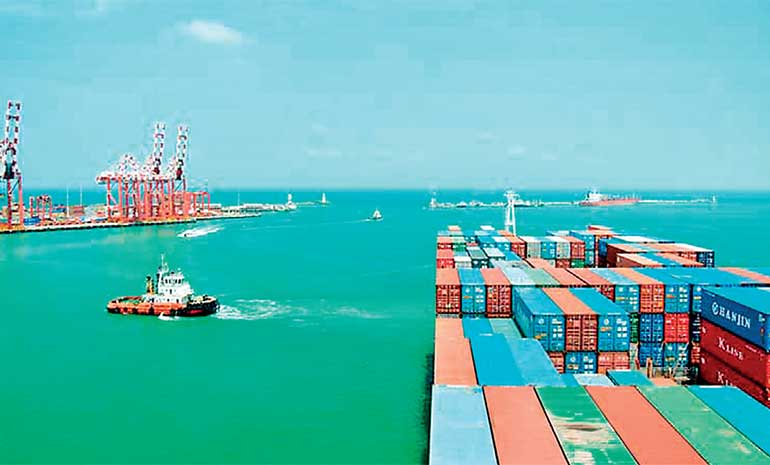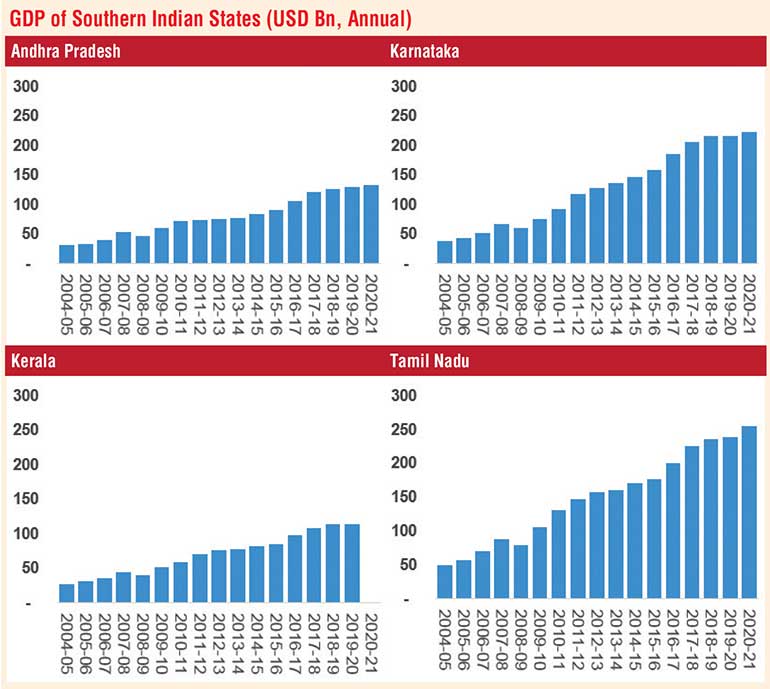Monday Dec 22, 2025
Monday Dec 22, 2025
Monday, 12 December 2022 00:25 - - {{hitsCtrl.values.hits}}

While India is a very significant trading partner for imports, our exports to India are not so significant

Introduction
Relationship between Sri Lanka and India goes back to many thousands of years and is inextricably linked in many aspects including language, religion, culture, culinary and literature. The two countries share many similarities. Buddhism, Sri Lanka’s main religion originated in India while the Sinhala language has been enriched by many languages of Indian origin.
While history boasts of significant relationships between the two countries, it is also important to explore and understand how Sri Lanka should benefit from the economic expansion in the subcontinent, particularly economic ascension of India. According to IMF projections, reported by ‘economictimes newspaper’, India has overtaken the UK to become the world’s fifth-largest economy and is now behind only the US, China, Japan and Germany. South Asia is home to a quarter of the global population while population in India has reached 1.4 billion in 2021. Most South Asian economies, including India and Bangladesh have been growing at a much faster rate than the rest of the world in the recent decades.
Many efforts were taken to enhance economic cooperation between Sri Lanka and India in the past. Nevertheless, no meaningful and comprehensive dialog has taken place to strengthen economic integration between the two countries. While Sri Lanka is going through a major economic crisis and structural reforms are endorsed by the IMF to revitalise its ailing economy, it is timely to strategise how best Sri Lanka can integrate the economy with that of India to benefit from the long-term growth prospects of Indian economic ascend.
The economic integration with broader South Asia and particularly with India are two folds.
Sri Lanka and India have signed a free trade agreement; however, its utilisation, depth and breadth could be improved to benefit from enhanced trade and investment from India to Sri Lanka. While India is a very significant trading partner for imports, our exports to India are not so significant. Although many Indian corporate giants have reached Sri Lanka, a large number of private enterprises are yet to see Sri Lanka as an extension to their business ventures.
In order to attract more Indian enterprises to set up trade and investment ventures in Sri Lanka, the country should improve its ‘Doing Business Ranking’ to be the No. 1 in South Asia. Further, it is necessary that Sri Lanka carries out a major campaign promoting Sri Lanka as a business destination among Indian business leagues. Most states in South India, in close proximity to Sri Lanka are growing at a fast rate and there is huge visible expansion in the middle class of South India. The travel time between Sri Lanka and most Southern states are less than rest of India. The physical infrastructure linkages between India and Sri Lanka with visa-free access to citizens of both countries should make Sri Lanka more easily accessible to those states.
Colombo is by far the best liveable city in South Asia. Colombo ranks very high in terms of cleanliness, air quality, pleasant weather, excellent infrastructure and vibrant culture. The country’s policies should target encouraging more South Asians to live in Sri Lanka, particularly making Colombo as the most preferred destination. For improving the connectivity, road, rail, air and sea linkages between South India and Sri Lanka should be established on a priority basis.
Despite many proposals, ferry service between India and Sri Lanka stopped in 1980s and was not reinvigorated. Recommencement of ferry services will enable Indian travellers to reach Sri Lanka easily via the North. Further, main road linkages between South India and Sri Lanka will enable many travellers to reach the country via road, especially for tourism and trade purpose. Similarly, railroad linkage between India and Sri Lanka connecting main South Indian destinations could play a vital role in enhancing connectivity, trade and tourism.
Regional integration
According to the World Bank publication, regional cooperation has the potential to produce significant gains across all countries of South Asia. Intraregional trade now stands at just one-fifth of its potential with an estimated gap of $ 44 billion annually. An electricity market of the BBIN countries – Bangladesh, Bhutan, India, and Nepal – would save an estimated $ 17 billion in capital costs. And improvements in transport and logistics can reduce the 50% higher cost for container shipments in South Asia compared to OECD nations.”
Exploration of hydrocarbon resources
The country has been struggling to explore petroleum resources in the Mannar Basin despite several studies confirming the availability of commercially viable hydrocarbon resources. The country should devise a mechanism to attract international energy players to commercially explore hydrocarbon resources available in the Mannar Basin. Sri Lanka should seek Indian private sector assistance to explore the hydro carbon resources in Mannar Basin.
Labour market
Despite series outward labour migration due to the economic crisis, Sri Lanka employs quite a large number of Indian labour, mainly in low and unskilled segments. The development of the industrial sector while maintaining the cost competitiveness in terms of labour cost is a huge challenge. In the medium term, complete liberalisation of labour market, allowing foreign workers from South Asia will be required.
Education
Universities in Sri Lanka have produced outstanding graduates. However, there is a need for more internationally accredited higher education institutes which offer world-class education especially in the technology field. Indian Institute of Technology (IIT network) is one of the best technological education institutes in the region. IIT has established 23 institutes around the main Indian cities. The graduates from IIT network are among the best corporate executives in world leading corporates and IIT claims very high reputation for high-quality education. Sri Lanka should seek assistance from the Indian government to set up IIT and institutes like AIMS in Colombo for upgrading higher education and offer more opportunities in higher education.
Sports
Playing Indian Premier League (IPL) in Sri Lanka is a distant possibility. Even when India could not host IPL, Sri Lanka was never considered as a venue despite the country being India’s friendliest neighbour. Sri Lanka should engage with the Indian government and Board of Control for Cricket in India (BCCI) to integrate Colombo as a permanent team and venue for IPL. Sri Lanka offers much more vibrancy in terms of night life, natural beauty and ease of travelling than most Indian cities, making it a perfect location for hosting IPL matches.
Integration with Indian electricity grid
Integrating Sri Lankan national electricity grid with that of India in order to ensure continuous energy supply, thereby improving our economic competitiveness should be a priority initiative. Cross-border electricity trade in the Bangladesh-Bhutan-India-Nepal (BBIN) Region is a good example for Sri Lanka to consider the benefits of interconnectedness of electrical grids.
Despite vast potential of hydropower, Nepal had faced serious difficulty in meeting its energy demand. Long power cuts were prevalent in the past. Consequently, Nepal undertook the development of large-scale hydropower plants while integrating its national grid with India. This allows Nepal to export excess energy generated in the rainy season when the hydro plants are running at full capacity. In the dry season Nepal imports energy from India. This grid integration has provided Nepal with uninterrupted power supply at a relatively cost-efficient manner.
Similarly, Bhutan is also connected with the Indian grid. Bhutan, being a country with rich natural hydro resources, has potential to produce large excess hydro energy. This grid integration has provided Bhutan with the opportunity to export excess energy to India. Cross-border electricity trade in the Bangladesh-Bhutan-India-Nepal (BBIN) Region facilitated these countries to provide uninterrupted energy for their industries while managing their national grid effectively with large renewable energy plants.
The integration of our national grid with the Indian electricity grid should enable us to harness the full potential of vast wind and solar resources available in the North.

(The writer is a CFA charterholder; capital market specialist and Certified FRM. The views and opinions expressed in this article are those of the writer and do not necessarily reflect the official policy or position of any institution.)